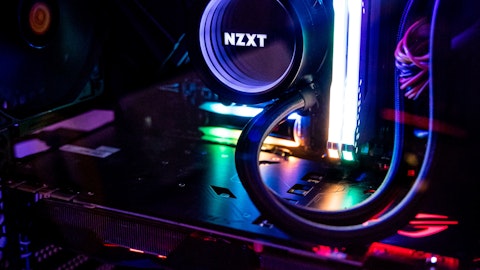Operator: Our next question comes from Vivek Arya with Bank of America.
Vivek Arya: Matt, I’m trying to see what is the range of kind of scenarios for fiscal ’24 sales growth? I understand you’re not giving a specific number. It would be helpful if you give us at least kind of a range. Can Marvell grow next year? Because when I look at the three areas, cloud and 5G, and autos, I believe it’s about 35%, 40% of business. Can those three areas collectively grow fast enough to offset the inventory correction in other areas? Like, so should we be thinking about flat or mid-single digit? What’s the kind of range of scenarios of growth that we should be thinking about for fiscal ’24?
Matt Murphy : Yes. Great question, Vivek. And certainly, I’d frame all this by saying it’s still a very dynamic environment. So we’ll give you the best view we can. I’d say the first point is we feel very good about the new products that are ramping up and the growth drivers that we’ve articulated, whether it’s cloud optimized silicon, switching, electro-optics, things like that in the data center, 5G, obviously, continued momentum there with additional regions like India ramping next year plus content gain rolling through and then automotive continuing to grow. So those are all the positives. What we don’t know completely, but I’ll give you the best color I can is on the base business and how much of the inventory correction we’re going to be dealing with and the magnitude of that.
We anticipate, first of all, that that’s like typical cycles. It’s probably a couple of quarters to work its way through. And the three areas I would call out that probably are some offsets next year are, one, would be in consumer. That’s an area where we just haven’t put a lot of investment. We’ve been typically running that business for cash. You’ll probably see some decline there. I think on-premise data center is another area. The on-prem stuff probably has work to do next year. And then maybe a little bit in our wired infrastructure business. If you look, actually, it’s kind of interesting, if you go back to our fiscal ’22 and you look at those three areas, they all grew pretty dramatically in fiscal ’23, the current year we’re in. And so at a high level, I think some of those are probably going to trend back to where they were before this big up cycle.
And again, from a sort of a timing perspective, think of it as a lot of that headwind or weakness more in the first half, inventory works itself through, and then you have growth back off of that, plus you have the growth drivers kicking in. So I think it’s a very different story, most likely first half versus second half. But those are some of the moving pieces in terms of how you think about the growth drivers versus some of the offsets. But we do see — we still believe we can drive positive year-over-year growth. It just certainly isn’t going to be as high as we had been hoping for if you went back even three months ago, just given the magnitude of some of the inventory adjustments.
Operator: Our next question comes from Timothy Arcuri with UBS.
Timothy Arcuri : Matt, just along the same lines of that question. I’m just kind of wondering, if you can help us figure out what a reasonable baseline is in the data center business headed into next year? If you look at storage, I mean, it must be down about 50% sequentially in January, and you were obviously over-shipping the past few quarters and you’re really under-shipping now. But it seems like if you net all that out, maybe it’s kind of the $600 million per quarter baseline in data center and then you can add the $400 million for the cloud optimized silicon next year. Can you sort of help us handicap what a normalized run rate might be in that business?





